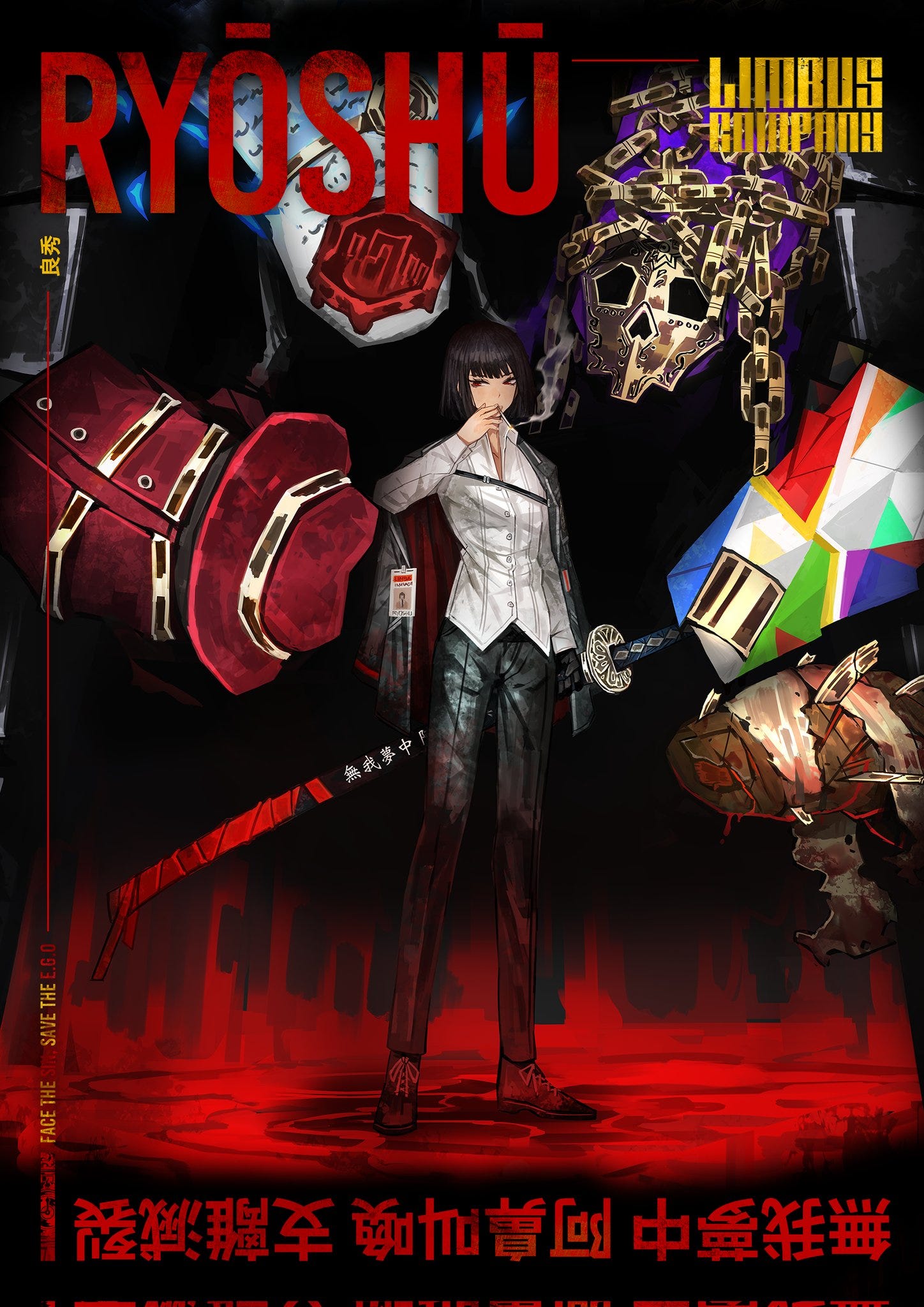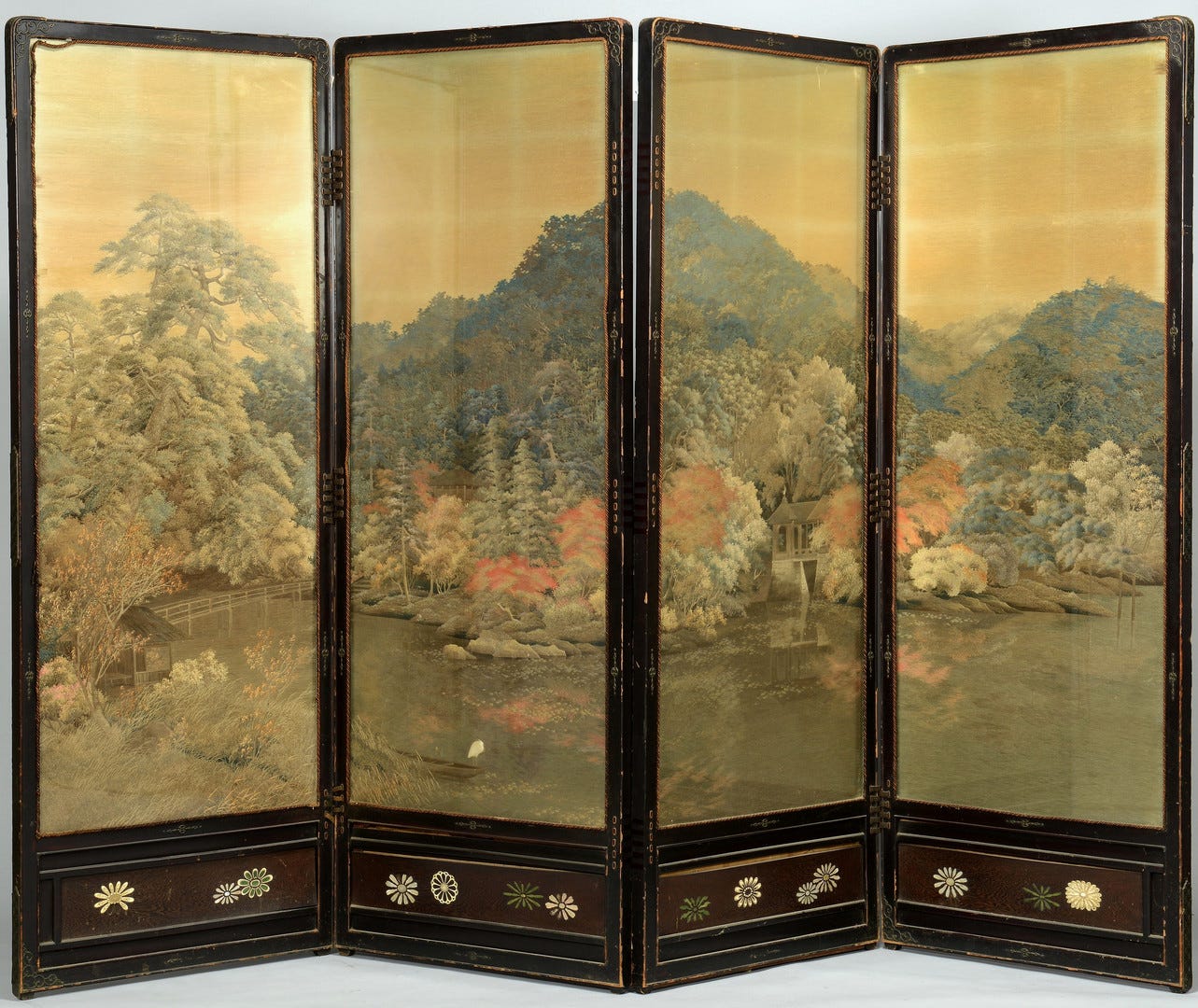English Class for Gacha Nerds, Part 9: Jigokuhen [Hell Screen]
Source inspiration for Sinner #4: Ryoshu.
So, uh, I’m a little bit of a Project Moon—and especially Limbus Company—fan, and in the absence of other long term projects the first thing that I might want to write about that comes to mind is picking through the Sinner/Canto source material for Limbus Company.
So why start with part 9? The most straightforward/obvious-to-LC-players reason is that we’re presently in the waiting period prior to Season 7 and the release of Canto 9, and speculating about its content will help fill a little of that void. Second, the Hell Screen is a short story, and so will likely be a better proof of concept than the Dream of the Red Chamber—which is supposedly very long and also may or may not be hard to find, despite being the most recent Canto—or Metamorphosis—which is short, but also the oldest Canto from back when each Canto’s content was much less directly tied to its source inspiration.
There’s a few other esoteric reasons for trying this out too; I guess I’d like to see if my present media criticism muscles can be turned on literature in an interesting way1. I’m curious if present me is right that high school me suffered under an insane lack of interesting course-proscribed material2. However, the true reason for all of this is that I was looking for something new to read and spontaneously decided to start the Limbus Company collection, and then prospectively thought I could pull some writing out of the whole thing, so here we are3.
Here’s the gameplan for these:
I’m going to try to do a little background discussion on the source story and its author if I can find such information readily available, partly for flavor and partly to tease out any interesting insights we can glean on the relationship between the original work and how it’s transcribed to Limbus Company.
We’ll do a summary of the story itself.
We’ll do a quick review of what we know of the relevant Sinner.
We’ll do a summary of the relevant Canto.
For the unreleased ones here’s where we’ll do a little bit of speculating.
I think I’m going to have to settle for editing these as new information becomes available and the Cantos get actually released.
A potential fifth section reserved for comparing and contrasting any points leftover that don’t fit in the above sections. This will likely be weightier for the finished Cantos, since there will be much to say about how they depart from their source material.
There’s an issue here that I’ll have to sort out for any of these with an unreleased Canto, where it will naturally demand a second part once the actual Canto is out in a way that won’t make sense if I want to be really clean about naming everything. As mentioned in the outline above, I think I’m just going to have to give myself license/be willing to do post-publishing editing, especially since I don’t have a really good sounding board for much of these ideas4.
So here goes, our first little experiment will be on Akutagawa Ryunosuke’s the Hell Screen.
I. The short stories of Akutagawa Ryunosuke
Akutagawa Ryunosuke was a Japanese author, well-known (especially in Japan) for his many short stories. He was born in 1892, was interested in Chinese literary classics from a young age, studied English literature at Tokyo Imperial University, and went on to have a lively literary career. He died of suicide at age 35, possibly as the result of inheriting his biological mother’s schizophrenia, or over severe anxiety that he might.
The copy I was able to find5 includes four of Akutagawa Ryunosuke’s stories6, including the titular Hell Screen, with an introduction by W. H. H. Norman (dated 1948), whom wikipedia says also first translated the story. In the introduction he explains that “jigokuhen” more literally translates as “aspects of hell” (or as Norman writes, with delightful irony for us, something akin to “circles of hell” in the style of Dante) but that he translated it as “hell screen” to more directly reflect the subject of the story7. Jigokuhen is considered one of Akutagawa’s masterpieces and has itself been adapted into Kabuki theater and other productions.
Jigokuhen’s main character, Yoshihide, is taken from another series of short stories, the Uji Shui Monogatari, by an unknown author from the Kenpo era (1213-1219). Jigokuhen refers to a few of these episodes. In one, the painter Ryoshu’s house catches fire from a neighbor’s burning house. Ryoshu flees his home without thought for his belongings or his wife and children (it’s not especially clear whether they survive), but when others come to console him he is happy having been shown how to realistically depict the flames of hell. As far as I can tell, Yoshihide being based on this Ryoshu is the source of the interchangeability of their names.
Yoshihide is described in Jigokuhen as “a famous painter, about fifty, short of stature, a bag of skin and bones, a very unpleasant person”, very unpopular but of his own fault, described again later as “bad-tempered, shameless, lazy, greedy, arrogant, and contemptuous”, but also, per Norman, not a complete monster of ambition and art—his one human trait is his boundless love for his only daughter. The original story doesn’t give her a name but the Norman translation uses the name Yuzuki, which had been used in subsequent Japanese adaptations of the story.
Jigokuhen has another sequel short story, Jashumon8, however it does not involve Yoshihide or the hell screen.
II. Jigokuhen: Plot Summary
The first chapter begins by describing “Otono Sama”, an anonymous “Great Daimyo” of Horikawa. The story of Otono Sama exorcising the ghost of Toru, told here, is also a reference to a story from the Uji Shui Monogatari. The translation doesn’t make it clear who our narrator is, but following from Jashumon they are a subject of Otono Sama’s palace and an uncle of one of Otono Sama’s samurai retainers. The second chapter describes Yoshihide as above.
Yoshihide’s daughter Yuzuki befriends a tamed monkey that had been presented to the court and named after her father by Wakatono Sama (“Young Daimyo”, Otono Sama’s son), which eventually endears her to Otono Sama, who invites her to join his palace—though there are immediately rumors that he is secretly attracted to her. This irritates Yoshihide, who is fiercely protective of her. On multiple occasions when Otono Sama is pleased with Yoshihide’s commissions and offers him any reward, Yoshihide asks that his daughter be released from Otono Sama’s service, but he is refused (the narrator notes again that the rumor is that he’s fallen in love with Yuzuki, though he personally suspects that it’s more likely that Otono Sama prefers to keep her away from her father’s poor reputation). These requests cause Yoshihide to gradually lose Otono Sama’s favor, until he is summoned one last time and ordered to produce a jigokuhen screen, a “screen of the circles of hell”.
The finished screen is described as a portrayal of the Japanese Buddhist hell, with descriptive imagery that’s culturally relatable to a western Christian audience: people of all class strata and walks of life being burned in flame and brutally, painfully tortured by various demons. The narrator notes a particularly vivid central depiction of a woman in a burning carriage and hints that something about its creation led to Yoshihide taking his own life.
The narrator goes on to describe the process of the screen’s creation, which involves episodes of Yoshihide scaring and torturing several of his apprentices in various ways that match images from the finished screen. As work continues Yoshihide’s behavior becomes more erratic, going to further extremes to find accurate models for his work.
Yuzuki is also said to have been behaving more erratic and melancholic, and is increasingly ostracized due to the rumors that Otono Sama wants to “have his way with her”. The narrator recounts an incident where her monkey frantically brings him to interrupt Yuzuki being assaulted by an unseen person, whom Yuzuki is afraid to name when questioned.
Yoshihide is unable to finish the screen without having personally witnessed the final central element as a reference. He pleads with Otono Sama to have a carriage burned so he can witness it. Otono Sama agrees, even offering to have a beautiful woman burned along with the carriage, unprompted by Yoshihide.
A ceremony is prepared at an estate outside of town. Shortly before the carriage is lit, it’s revealed to the gathered audience and Yoshihide that the girl bound in the carriage is Yuzuki. Yoshihide is initially horrified but the carriage is immediately lit before he is able to react and he instead watches entranced, “his soul taken captive by it”. The crowd also watches, horrified, but Otono Sama is observed behaving unusual as well. There are open rumors afterwards that Otono Sama had Yoshihide’s daughter killed for refusing his advances, though Otono Sama claims it was purely to punish Yoshihide.
A month after the screen is completed, the night after Yoshihide presents it to Otono Sama, he hangs himself in his room.
III. Ryoshu
As they say, every person has their own creed—and it’s only right to respect it as the Executive Manager. But with some creeds, you will have difficulty in even simply pretending to sympathize. You will have noticed that the Sinner in question is a silent chain-smoker whose eyes shine with a euphoric gleam only during battle. She believes that senselessly destroying the enemy’s heads is an uncultured act9 and a step backward for art.
If you are at your wit’s end, please press the red button included in your welcome kit.[CAUTION]: This Sinner’s background is one that even our company may have trouble handling; it is advised against making her breed personal resentment towards you.
Ryoshu is relatively taciturn amongst the Sinners, but not quite as succinctly asocial as compared to, say, Meursault. She’s curt and to the point, as indicated by her habit of condensing entire sentences into acronyms, which is itself referred to as SANGRIA (succinct abbreviation naturally germinates rather immaculate art). There’s an ongoing bit where for some reason only Sinclair ever understands what she’s saying when she does this and has to translate for the group.
Ryoshu’s Sinner icon is a tattered butterfly, the text on the icon translates as “Forest for the Flames”, which is also the name of her base EGO. Her introduction quote mirrors a conversation between Otono Sama and Yoshihide in Jigokuhen.
Other lesser painters are such mediocrities, they have no way to recognize the beauty that lies in ugliness.
Ryoshu seems to have a unique relationship with most, or possibly all10, of the Five Fingers. Like the literary Yoshihide, Ryoshu thinks of herself as an artist but her medium is violence, a predilection she shares with the Ring, though she doesn’t seem to hold them in high regard. She also has a clear direct relationship with the Thumb vis a vis Lei Heng, who also provides us with modest evidence that she may have formerly matched or exceeded him in rank (though not strictly from within the Thumb). She’s also keenly attuned to the Pinky despite their apparent secretiveness—Ryoshu seems to correctly identify Lei Heng is Pinky just from hearing the ringtone on his phone during the first round of the Family Hierarch Evaluation. She also demonstrates insight into the Middle and Ring in Cantos 5 & 6 respectively.
Personally, I suspect the "contract has depowered everyone" was using Don Quixote as a smokescreen to cover up Ryoshu's actual power level being Capo IIII+ level uber-high11. The one mystery wrinkle to this idea is that Outis was ranked in between the two.
Yoshihide's only positive character trait is that he really really really loves his daughter; it seems the Limbus Company translation here = "Ryoshu's good with kids". I was originally thinking the "child" referenced in Canto 8 could refer to whatever the Hell Screen is in this iteration but 8.5 seems to more heavily imply it's a literal child.
Despite her cold attitude, Ryoshu is certainly not without warmth. She chastises others for showing sentimentality but is conspicuously supportive of her teammates on occasion and, of course, we now know she’s delicate with young children.
IV. Canto IX: The Unsevering, speculation
Okay so there really isn’t much to say here at all. We don't really have much in the way of clues to who/where Otono Sama & Horikawa will turn out to be in the City, and vague clues as to whether a Yuzuki or the hell screen exists/still exists. We also don't know anything significant about Ryoshu's unique katana, which is the most notable thing that exists for her across most mirror worlds; the text on its sheath is a unique type of Japanese abbreviation that translates as something like “losing oneself in incoherent agonizing cries”.
Ryoshu is known to have connections to something called the Spider’s House, and that her “child” is “still at that house”, but this doesn’t seem to be something that’s cleanly analogous to the Yoshihide from Jigokuhen. If it’s some kind of organization, she seems likely to have had some sort of falling out with them. We don’t have much evidence what her agreement is with Limbus Company (nor what her connection to a Golden Bough is likely to be) but we might be able to speculate it will have some connection to whatever she’s left behind.
And there we are, for now. Ryoshu is probably narrowly my favorite amongst the Sinners, so I kind of have high hopes for her Canto. It’s also likely to be a fairly distinct and lore-dense chapter if it focuses on bringing all the Syndicates together. We’re supposed to see Canto 9 in December, historically we can predict delays but otoh they’ve promised to put out substantial additional content if they do, which would make such delays probably even more extreme, so who knows.
I realize calling this “English Class” is an extreme misnomer when most of everything we’ll touch here will not be in English but it just flows so much better as a sardonic title than “Literature Class for Gacha Nerds”. “Lit Class” is kind of snappy but it doesn’t appear to be an actual phrase people use.
Working on this has reminded me that how difficult it is for me to take notes on a work while also enjoying it, and I often feel like focusing on writing a coherent summary risks missing important details. I read a lot for enjoyment as a kid, and even now would prefer to enjoy something rather than spend tons of energy analyzing it. But we’ve already committed to a particular bit here so…
Also, I don’t know if anyone has actually done anything like this yet, at least in raw writing. There’s a ton of Project Moon fans doing video content on YouTube and there’s at least one extensive cataloguing of the literature references in their games, but video content on literature doesn’t strike me as attractive, personally. Actually, Last Minute Essays has videos on several of the older Cantos and I ought to at least take a peek when I get there…
I already corrected one inaccuracy that might have made it into this piece in passing discussion of the Hell Screen on the Steam forums.
Hell Screen (“Jigoku Hen”) and Other Stories by Ryunosuke Akutagawa, Translated from the Japanese by W. H. H. Norman. Published by Greenwood Press, Publishers; originally published 1948, reprinted 1971.
Rashomon is not among them but I was surprised to discover it’s one of Akutagawa’s short stories and that the Kurosawa film of the same name takes elements from that story and another Akutagawa story titled In a Grove.
Literally “false religion” and a term formerly used for Christianity in Japan. The story involves a sinister and enigmatic Japanese Christian convert and missionary.
Reminder: in the world of Limbus Company & Project Moon, resurrection is a taboo of the Head. There are several loopholes that exist that have the same apparent effect but in most cases this requires the subject’s head be intact (Dante’s restoration ability is an unusual exception). The soft implication here is that Ryoshu prefers to torture and maim her opponents but finds outright murdering them to be distasteful.
Implied by the art in her introduction, as can be seen above; the five symbols surrounding her represent each of the Five Fingers, in order.
We also have circumstantial evidence of this in how Lei Heng (doesn’t) react to her disrespect, and he later claims that she should have been capable of defeating him with ease if she “unsheathed her blade”.






